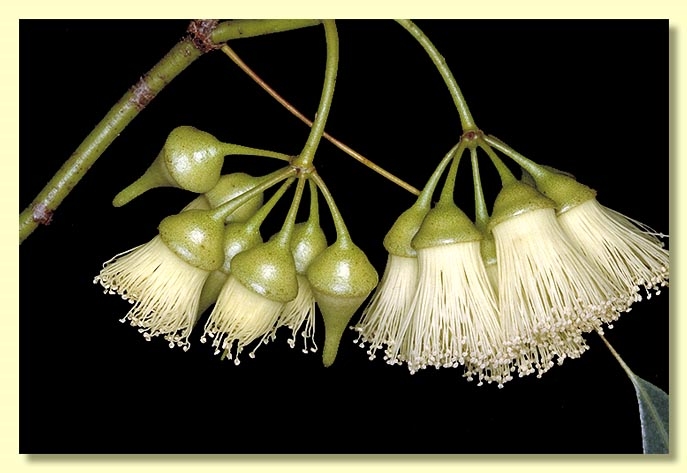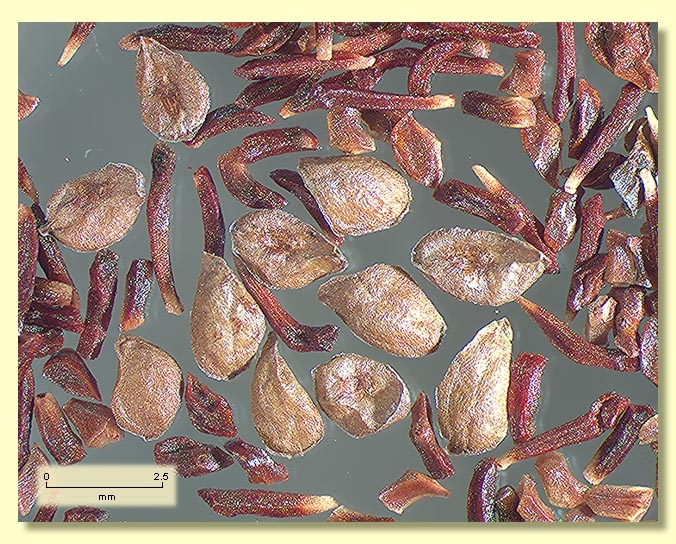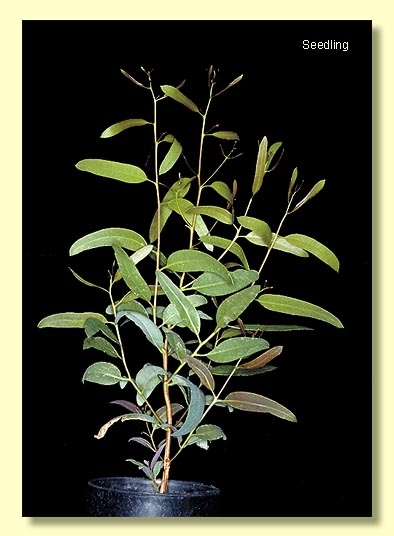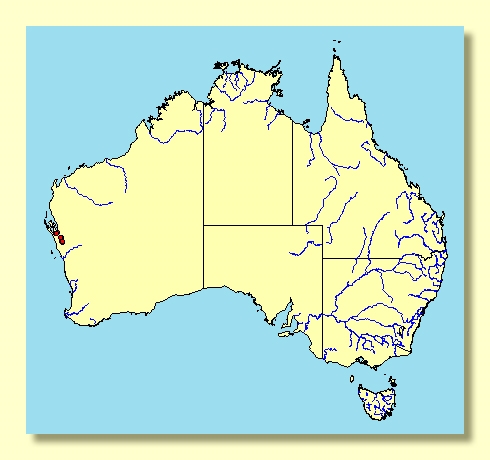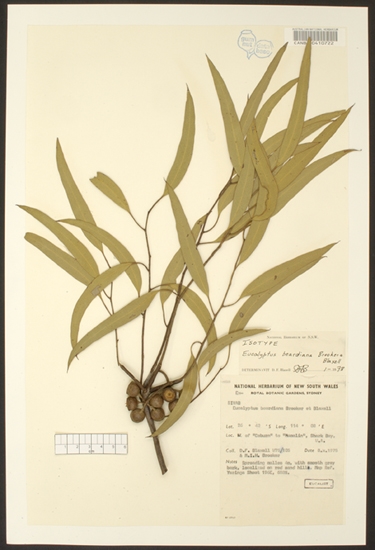Eucalyptus | Symphyomyrtus | Bisectae | Destitutae | Curviptera | Synandrae
Euclid - Online edition
Eucalyptus beardiana
Bark smooth throughout, pink and pink-grey (sometimes with thin curls of semi-persistent bark forming an attractive ring 5 cm high at the base of the trunk).
Branchlets lacking oil glands in the pith.
Juvenile growth (coppice or field seedlings to 50 cm): stems rounded in cross-section; juvenile leaves always petiolate, alternate, narrowly lanceolate, 2–9 cm long, 0.5–3.5 cm wide, dull, green.
Adult leaves alternate, petioles 0.9–2.3 cm long; blade narrowly lanceolate to falcate, 5.5–13(15) cm long, 0.7–1.5 cm wide, base tapering to petiole, margin entire, concolorous, dull, green, or rarely grey-green, side-veins greater than 45° to midrib, reticulation dense, intramarginal vein close to margin, oil glands intersectional, scattered.
Inflorescence axillary unbranched, pendulous, peduncles 2–3 cm long, buds 9 (rarely 11) per umbel, pedicels 0.4–1.4 cm long. Mature buds ovoid (1.9–2.2 cm long, 0.7–0.9 cm wide), scar present, operculum finely beaked (1.4 cm long), stamens connate into a tube for basal half, a few outer filaments erect or all inflexed to varying degrees, anthers cuboid, versatile, dorsifixed, dehiscing by longitudinal slits, style long and straight, stigma blunt to tapered, locules 5 or 6, the placentae each with 4 vertical rows of ovules. Flowers pale yellow.
Fruit down-turned, pedicellate (pedicels 0.4–1.5 cm long), hemispherical, sometimes contracted just below rim or with rim flared slightly, 0.6–1 cm long, 0.9–1.3 cm wide, disc level or slightly raised, whitish, valves 5 or 6, near rim level.
Seeds brown, 2–3 mm long, angularly ovoid, scarcely ridged ventrally, partial flange ssometimes present around seed, dorsal surface shallowly reticulate, hilum ventral.
Cultivated seedlings (measured at ca node 10): cotyledons Y-shaped (bisected); stems rounded in cross-section, warty or smooth; leaves always petiolate, opposite for ca 8 nodes then alternate, narrowly lanceolate, 4–7 cm long, 0.8–1.5 cm wide, dull, green.
Flowering has been recorded in May.
A mallee endemic to Western Australia, restricted to a small area of sand plain north of Perth between the Murchison River and Shark Bay. The bark is smooth, pinkish grey, the adult leaves are narrow and dull to slightly glossy, light green and the inflorescences are down-curved on slender peduncles.
Eucalyptus beardiana belongs in Eucalyptus subgenus Symphyomyrtus section Bisectae subsection Destitutae because buds have two opercula, cotyledons are Y-shaped and branchlets lack oil glands in the pith. Within this subsection E. beardiana is in series Curviptera, one of about 30 closely related species and subspecies which are further characterised by having large buds in umbels of one, three or seven, staminal filaments erect or oblique (rarely inflexed) in bud, and large fruit usually with an ascending disc and exserted valves.
Within series Curviptera this species has only two close relatives, E. synandra and E. rosacea, all with an unusual feature that occurs nowhere else in the genus Eucalyptus — the stamens are united basally into a short tube. Together they form subseries Synandrae. The pale yellow stamens of E. beardiana fall intact as a frilly tube and in season are easily recognised on the ground beneath the mallees. E. synandra, which is of rare occurrence in the eastern part of the northern wheatbelt from Morawa south-east to Karroun Hill, differs from E. beardiana by the powdery white bark, sprawling habit, much longer leaves, the fruit with a strongly ascending disc and white to pink flowers. E. rosacea, an arid zone species from east of Laverton and Queen Victoria Springs towards Neale Junction in the Great Victoria Desert, is an erect mallee, with non-powdery bark and fruit with a raised disc but not as strongly raised as in E. synandra, and pink, cream or red flowers.
Eucalyptus beardiana is listed as "Endangered" under the Australian Government Environment Protection and Biodiversity Conservation Act 1999 (EPBC Act). Further information may be found at this web address:
http://www.environment.gov.au/cgi-bin/sprat/public/sprat.pl




